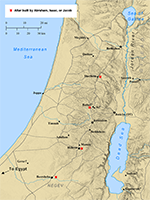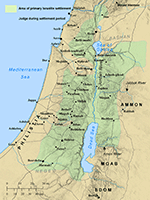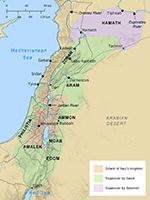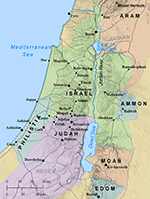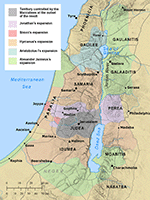
Geography of Ancient Israel
On the eastern shores of the Mediterranean Sea, Israel existed in the region known as the "Levant." This word derives from the French word lever, which means "to rise," as in sunrise, (the east). Historically, the Levant ranged from modern-day Egypt to Turkey. The Southern Levant includes the modern-day states of Israel, Palestine, Jordan, and southern parts of Syria and Lebanon.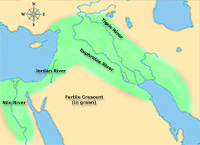 Located within the ancient middle east was a crescent-shaped region ("fertile crescent"), that was home to some of the earliest human civilizations. This region was fertile because it had water sources that were essential for the rise of civilization, ( i.e. the Tigris, Euphrates, Jordan, and Nile rivers).
Located within the ancient middle east was a crescent-shaped region ("fertile crescent"), that was home to some of the earliest human civilizations. This region was fertile because it had water sources that were essential for the rise of civilization, ( i.e. the Tigris, Euphrates, Jordan, and Nile rivers).
Topography of Israel
One way to understand Israel's topography is to divide the land into five longitudinal zones. From west to east, the longitudinal zones include: the Coastal Plain, the Shephelah, the Cis-Jordan, the Jordan Valley, and the Trans-Jordan. The Coastal Plain is located along the coast of the Mediterranean Sea. There were few natural harbors on the Coastal Plain, but the few that it had were famously occupied by the Phoenicians in the north and the Philistines in the south, (the latter with their five city-states: Gaza, Ashkelon, Asdod, Gath, and Ekron). In the middle was a marshy area known as the "Plain of Sharon."
Moving eastward, one next comes to the zone known as the Shephelah. Located about twenty miles inland, the Shephelah ("lowlands") consists of foothills leading from the Coastal Plain to the hill country of the Cis-Jordan. In between the foothills are valleys of various sizes that provide fertile crop-land and local trade routes. The Cis-Jordan is the next longitudinal zone toward the east. "Cis-Jordan" is Latin for "this side of Jordan," (reckoned from Jerusalem). It was the land along the western bank of the Jordan River. (Later, Cis-Jordan came to be used as a term for the entire area ranging from the western bank of the Jordan River to the Mediterranean Sea).
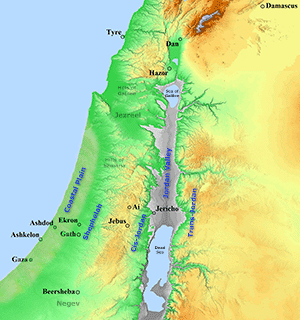
Within the Cis-Jordan is the hill country that is further broken up by two east-west valleys: the Jezreel/Esdraelon Valley in the northern part of the country, and the Negev of Judah in the south. The hill country divisions are the following: in the north, the Hill Country of Galilee , in the middle (mid-north) the hill country of Samaria/Ephraim, in the middle (mid-south), the hill country of Judah and the Wilderness Highlands in the south. The majority of the events that the Hebrew Bible describes were set in the Shephelah and the hill country of the Cis-Jordan.
Moving from coastal plain to Cis-Jordan one moves up in altitude. However, on the eastern side of the hill country of the Cis-Jordan is the Jordan Valley with much lower elevations. The valley is part of an elongated north-south depression known as the Syro-African Rift (4,000 miles) created by the movement of the Arabian and African Tectonic plates. As a result of this depression, some of the lowest places on earth are located there.
Jerusalem (located in the hill country of Judah) has an elevation of 2,474 ft above sea level. As one travels down the eastern side of the hill country of Judah, one descends into the Jordan Valley whose lowest point is 1,300 ft below sea level. Located in this valley are some of Israel’s main bodies of water: the entire length of the Jordan River (including its sources in the north), flowing in and out of the Sea of Galilee, and then on down to the Dead Sea. Both the Sea of Galilee and the Dead Sea are two of the lowest bodies of water in the world.
The Sea of Galilee is the lowest freshwater lake and second lowest lake in the world (between 705 ft and 686 ft below sea level). The Dead Sea is the lowest place on earth with its surface at 1,412 ft below sea level. Due to its location in the rift, water flows in but it doesn’t flow out, resulting in high concentrations of salt and minerals. Consequently, the Dead Sea is one of the world’s saltiest bodies of water, with a salinity of 34.2%, (making it 9.6 times as salty as the ocean). This extreme salinity creates a harsh environment where few plants or animals can thrive.
The final eastward longitudinal zone is the Trans-Jordan, which means "across the Jordan." The Trans-Jordan is a plateau divided into five regions. From North to South these are: Bashan, Gilead, Ammon, Moab, and Edom, divided by four east-west wadis or dry river beds (Yarmuk, Jabbok, Arnon, and Zered). As neighbors of ancient Israel, the inhabitants of the five regions are regularly mentioned in the Hebrew Bible.
The rolling lowlands and shallow valleys of the Shephelah was fertile land and highly desirable. Early on, the Israelites primarily settled in the hill country but soon wanted to expand into the more fertile Shephelah. The Philistines, who settled on the southern Coastal Plain, also wanted to expand into the Shephelah, leading to the conflicts the Bible describes between these two groups.
Locations of pertinence changed over the centuries as the people and events affecting Israel came and went. The major periods in the history are here divided into six spans of time. Each of these is illustrated with a clickable map in the side column.
